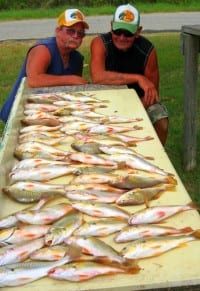 By Ed Snyder/Outdoors
By Ed Snyder/Outdoors
Rollover Pass, Gilchrist on Bolivar, TX.
Small in size but HUGE in popularity as a food fish…then enter the FUN factor into the equation and the croaker becomes a key ingredient for fishing folks when explaining the annual phenomenon of the Autumn’s Golden Croaker run here at Rollover Pass.
A member of the Drum family, croaker seldom attain weights over a pound. Although during its annual fall run, adult golden croaker have been known to reach 19 inches in length and four pounds in weight. But normal catches of croaker during its fall migration often run about a half-pound to a pound. But here, numbers of fish catches far outweigh the poundage caught.
Related to its much larger cousins the redfish and black drum, the golden croaker are often mistaken for other species such as yellow tail (sand perch) spots (a croaker like fish with a spot near its gill) and unfortunately the rat red (undersized redfish) and puppy drum (undersized black drum). All of these fish make grunting sounds similar to that of the croaker. So it’s best that you really know their differences or you could be ticketed by Texas Fish & Game officers. Croaker, yellow tail, and spots have no size or creel limits, but redfish are slot fish with 20 to 28 inch size limits with black drum having slot limits of 14 to 30 inch size limits. And the fines for keeping undersized or oversized reds and drums can be very expensive and severe.

Kids 'n Croaker fishing create tons of fun
The Golden Croaker (Micropogonias undulates), an Atlantic species, can be found from New England all the way down the eastern coast into the Gulf of Mexico. Fished for all along the Texas coast in bays, cuts, and estuaries, the croaker can also be found offshore in waters as deep as 300 feet around offshore oil and gas rigs. But inshore anglers can have their fun during the fall when the croaker begin a massive migration from the bays to spawn in the deeper waters of the Gulf during winter.
Getting its name from vibrating their air bladders to attract females during spawning season, the croaking sounds the males make can even be heard above the surface of the water when huge schools mass under piers, boats, or docks. After spawning in the Gulf, tides and currents will carry the free-floating croaker eggs and larvae back to inshore bays estuaries and nursery grounds, where they quickly develop as bottom dwellers eating worms, crustaceans, mollusks, small fish, and insects growing to a one half/pound size within just one year. By their second year they begin taking on the bronze-like golden hues of adult croaker. As the bay waters begin to cool, the adult croaker start teeming into massive schools to start their spawning migration back towards the Gulf.

DINNER IS SERVED - once this father and son team, Morris and Kevon Louvier of Sour Lake, clean this mess of croaker
When huge schools of croaker begin moving through the passes and cuts they are in competition for the food and will often hit the bait really hard (no sissy nibbles here folks) and can often rip your rod into the water within a blink of an eye. So keep your eye on your rod, in fact, when the run is on I strongly advise keeping your rod in your hands at all times or at least in a rod holder. This type of fishing is made for ultra-lite anglers who enjoy the fight that these fish can give. So, ultra-lite rods and reels will help to max out your need for adrenalin rushes and provide you with some excellent table fare. The croaker will also hit small Berkely Gulp products as well.
Excellent eating, golden croaker are often a preferred table fish by many anglers over the more promoted game fish species such as redfish and flounder (yes flounder) with golden croaker having a very sweet and delicate flavor when deep fried or grilled and basted to a golden brown. I find the flavor of golden croaker superior to that of redfish.
My favorite golden croaker fishing spots are Rollover Pass, situated at Gilchrist TX, on Hwy-87 on the Bolivar Peninsula, Sea Wolf Park, located on Pelican Island in the Galveston Island shipping area, the Brazos County RV Park at San Luis Pass, situated on the Freeport side of the San Luis Pass bridge, and Texas City Dike, on the bayside of Texas City, which extends eight miles out into Galveston Bay.

This SMILE says it all
This is meat-fishing at its finest with adults and children of all ages having tons of fun catching a lot of fish in just a very short time. It’s also a great way to get your children interested in fishing as the steady fishing action will keep them excited catching fish and encourage the positive influence of family sportsmanship into their lives.
There are several ways to prepare croaker for your supper table but my favorite is simply to scale and clean the fish whole then coat the fish in Cajun fish fry seasoning or 50/50 mixture of self rising flour and cornmeal before deep frying them in corn or peanut oil. When the fish float to the top crispy brown remove and drain on paper towels. Lightly season with Tony Chachere’s Creole seasoning then serve with your favorite chilled brew. This recipe is for the hand sized croaker (8 to 10 inches) where you’ll have to beware of the fish bones. But if you’re lucky enough to catch the man-sized croaker (12 to 15 inches) then by all means filet them and cook them the same way as above.
Croaker are very tasty and definitely will get you hooked on catching them as well as eating them. Bon Appetit!

 Posted in
Posted in 

























Pretty part of content. I simply stumbled upon your website and in accession capital to claim that I acquire in fact enjoyed account your blog posts. Anyway I will be subscribing in your feeds or even I success you access persistently fast.